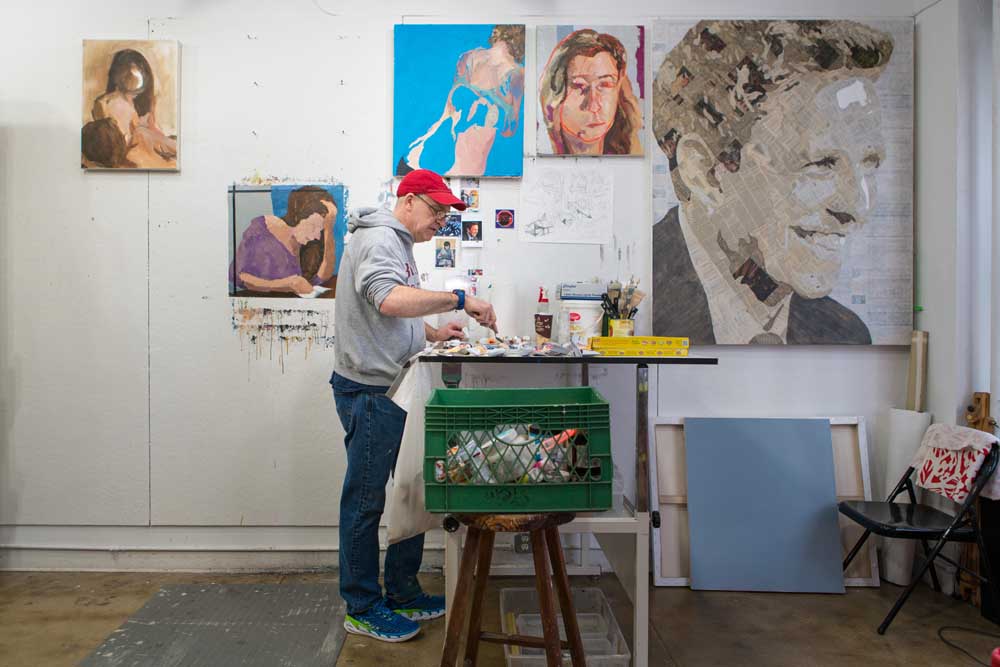Older artists starting to sell more online
Published 12:00 am Sunday, February 18, 2018

- Geoffrey Stein at work in his midtown Manhattan studio, Feb. 2, 2018. Visual artists of earlier generations are shifting to social media and other digital platforms, realizing they can’t rely solely on physical galleries. (Emon Hassan/The New York Times)
Suzanne Massion has been making art her whole life.
Massion, now 72 and living outside Chicago, said she couldn’t remember a time when she didn’t paint or draw — including her young adult years, which she spent on a dairy farm, and her time selling annuities for a savings and loan. For the last quarter-century, however, her artwork has become more than just a hobby. It’s now her main endeavor.
But relying solely on the traditional brick-and-mortar gallery to sell her art isn’t working for her anymore. In October, after going nearly two years without a sale at a gallery where she had a nine-year relationship with the owner, she decided to market her pieces more energetically online.
Massion now exhibits primarily at ugallery.com, a San Francisco-based juried site, expanding from a small presence there. And she has gotten results: She sold four pieces from the site in December alone.
Massion is following a path taken by other older artists who, eager to continue creating and attempting to earn a living from art in their retirement, are turning to online sales to supplement or replace their gallery ties. With the change, older artists are having to learn to engage with an ever-widening pool of buyers on the internet.
The experience can be unsettling, she said.
“Going online and selling online was for me hitting a brick wall. The technological aspect of selling art online was foreign to me,” said Massion, who had a steep learning curve, starting with learning how to upload digital images.
The move to online sales is happening as drawings and photos are more frequently shared on sites like Facebook, Pinterest and Instagram, whether by professional artists or hobbyists. “The growth of social media has made artists of us all,” said David Winton, the chief executive of Kalisher, a company outside Chapel Hill, North Carolina, that places original art in businesses and other commercial spaces.
Given the growth in online art sales globally, making such a shift would be a smart move for artists. A report issued last year by the British insurer Hiscox showed sales on the online art market in 2016 were up 15 percent over the previous year, reaching $3.75 billion. In 2015, sales were at $3.27 billion, a 24 percent increase from 2014.
Matthew Dibble, 60, a roofer in Cleveland, painted in the off season for three decades before turning to art full time. He began posting his work — large-scale abstract paintings with vigorous brush strokes — on Facebook in 2009, not because he was thinking about selling, but because he was attracted to the idea that a post could be seen and shared by people around the world, he said. He got hooked on the platform after making his first online sale there, to a collector in France — even though at $1,500 it was a lower price than his work had been fetching. He later added accounts on Pinterest and Instagram, where he has more than 15,000 followers.
Since 2012, he has exhibited on saatchiart.com, a large commercial online outlet that displays more than 500 of his paintings, ranging in price from $2,500 to $10,000. He estimates he sells three to four works on the site a year. Working with the site, he said, “has allowed me to expand my audience and has helped me gain confidence and a new sense of optimism for the future.”
After a representative from Kalisher scouted Saatchi.com seeking Cleveland artists for a local client, Dibble landed a big commission in 2015. The result: 24 paintings hung as a single unit on display in the Hilton Cleveland Downtown Hotel. He earned just over $19,000 for the job.
Geoffrey Stein, 57, a former lawyer who now paints full time, was forced to make a change when a Westchester County gallery that displayed his work, Lionheart, closed last fall after the gallery owner died. The gallery director, Susan D. Grissom, took the inventory online, calling the new site paraphe.art. The power of social media influenced her decision. “Instagram is your new storefront,” she said.
Stein still sees a need to continue marketing in the physical world. He has been keeping some work with a gallery in Britain while also being digitally savvy. “Artists will need more than one platform,” he said.
To be sure, there can be some potential downsides to going online, but even those are changing. Artists have long relied on traditional galleries, for example, to navigate contracts and help them market their work. Now, online galleries are also bridging that gap. UGallery helps artists with pricing and offers advice about a professional path, and Saatchi Art has an artists-relations team.
“We help the artist prepare for every shipment, no matter how complicated, and act as his or her liaison with the courier services, managing any customs clearance issues on behalf of the artist and the art buyer,” Saatchi’s chief curator, Rebecca Wilson, said in an email.
Artists who place their work on nonexclusive sites also need to be familiar with the terms, Grissom said. One artist who was showing her work online realized belatedly that she had agreed to a markdown of unsold units of a limited-edition work. Rather than sell the pieces at a discount, the artist removed her remaining work from the site.
For now, the two business models, off- and online, coexist.
Regardless of where one sells, Dibble said, “the hardest thing in the world is to sell a painting at a fair price.” So he’s keeping his ties to brick-and-mortar galleries in Charlotte, North Carolina; Cleveland; and New York City, while remembering that unlike them, the internet never closes.






